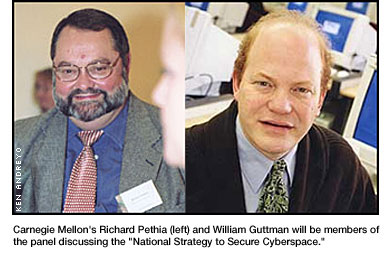|
|
||||
|
|
Carnegie Mellon Hosts White House Town Meeting on Cybersecurity Carnegie Mellon will host a White House town meeting to raise awareness of the "National Strategy to Secure Cyberspace," a draft document written by President George W. Bush's Critical Infrastructure Protection Board. The meeting, one of several being held across the country, will be held from 7 - 9 p.m., Thursday, Oct. 24 in McConomy Auditorium in Carnegie Mellon's University Center. The public is invited to attend. Leading the discussion will be Howard A. Schmidt, President Bush's special assistant for cyberspace security. Panel members will include Richard Pethia, director of the CERT Coordination Center, the world's first and foremost computer emergency response center, at the Software Engineering Institute at Carnegie Mellon; Martin G. McGuinn, chairman and CEO of Mellon Financial Corporation; and William Guttman, distinguished service professor of economics and technology at Carnegie Mellon's H. John Heinz III School of Public Policy and Management.
The draft National Strategy to Secure Cyberspace was developed in response to President Bush's executive order to empower every American to secure their portion of cyberspace. The strategy identifies 24 strategic goals and provides 86 recommendations on how America can make cyberspace more secure. The document provides recommendations, strategic goals, programs, discussion items and guidance at five levels: The Home User and Small Business; Large Enterprise; Sectors of the Economy; National Issues; and Global Issues. The strategy is a road map to ensure the protection of information systems of critical infrastructures and the physical assets that support each system. It supplements the Homeland Security Strategy and the National Security Strategy.
For more information on the strategy and to download the document see
www.securecyberspace.gov.
|
||
|
Carnegie Mellon Home |
||||
 Guttman is also co-director of the Sustainable Computing Consortium, a
coalition of leading businesses, software developers and federal agencies
formed to address software dependability, quality and security issues.
Guttman is also co-director of the Sustainable Computing Consortium, a
coalition of leading businesses, software developers and federal agencies
formed to address software dependability, quality and security issues.